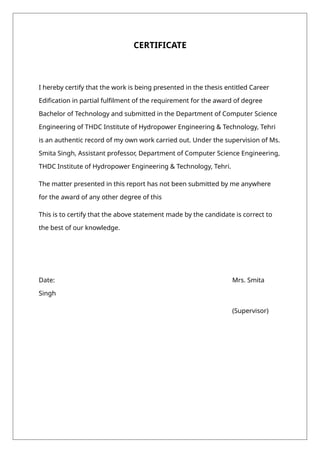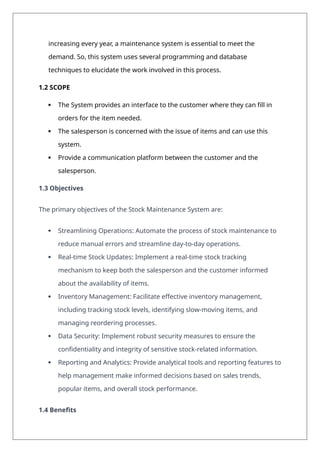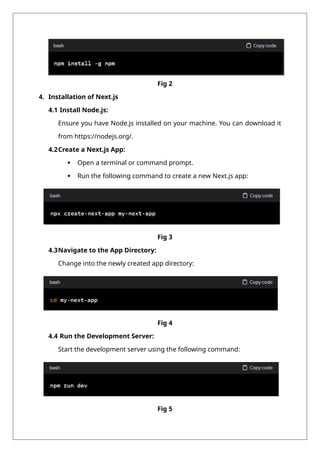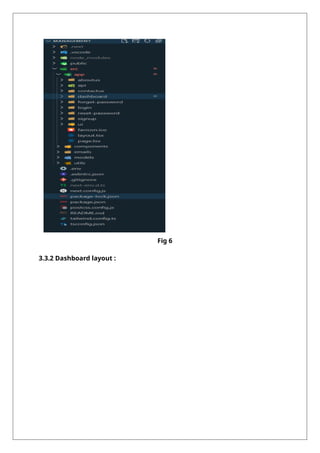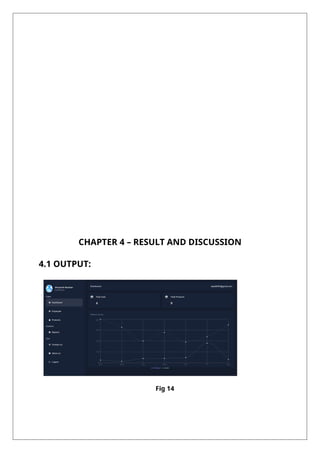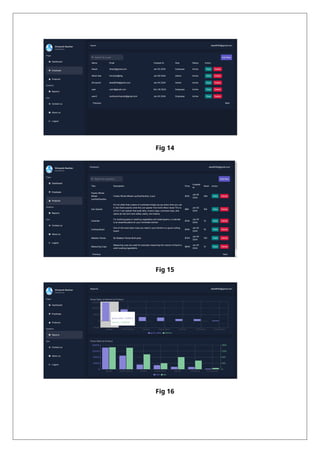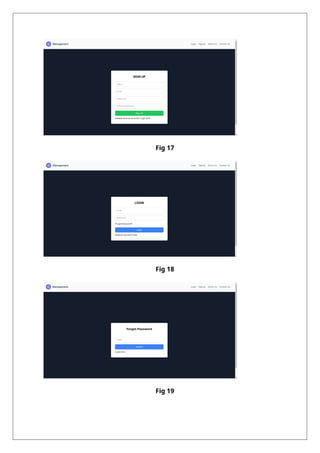software Documentation Certificate in department of computer
- 1. CERTIFICATE I hereby certify that the work is being presented in the thesis entitled Career Edification in partial fulfilment of the requirement for the award of degree Bachelor of Technology and submitted in the Department of Computer Science Engineering of THDC Institute of Hydropower Engineering & Technology, Tehri is an authentic record of my own work carried out. Under the supervision of Ms. Smita Singh, Assistant professor, Department of Computer Science Engineering, THDC Institute of Hydropower Engineering & Technology, Tehri. The matter presented in this report has not been submitted by me anywhere for the award of any other degree of this This is to certify that the above statement made by the candidate is correct to the best of our knowledge. Date: Mrs. Smita Singh (Supervisor)
- 3. ABSTRACT Next.js 14 is the latest version of the popular React framework, designed to improve the developer experience and enhance the performance of web applications. Next.js 14 is primarily used for building server-side rendered and static web applications. It provides a robust set of features such as pre- rendering, server-side rendering, static site generation, and much more. These features make it an excellent choice for developers building highly performant, SEO-friendly web applications. In our report, we have built a website based on Retail Sales and Inventory Analysis using Next.js 14. The stock maintenance system must take care of sales information of the company and must analyse the potential of the trade. It maintains the number of items that are added or removed. The salesperson initiated this Use case. The salesperson is allowed to update information and view the database.
- 4. LIST OF FIGURES S.NO TITLE PAGE NO. 1 Fig 1 2 Fig 2 3 Fig 3
- 5. 4 Fig 4 5 Fig 5 6 Fig 6 7 Fig 7 8 Fig 8 9 Fig 9 10 Fig 10 11 Fig 11 12 Fig 12 13 Fig 13 14 Fig 14 15 Fig 15 16 Fig 16 17 Fig 17 18 Fig 18 19 Fig 19
- 6. TABLE OF CONTENTS CERTIFICATE……………………………………………………….. ACKNOWLEDGEMENT…………………………………………….. ABSTRACT……………………………………………….. LIST OF FIGURES………………………………………….. CHAPTER 1: INTRODUCTION………………………………………….. CHAPTER 2: METHODOLOGY USED………………………………………….. CHAPTER 3: SOFTWARE AND HARDWARE REQUIREMENTS………… CHAPTER 4: RESULT AND DISCUSSIONS……………………………….. CHAPTER 5: CONCLUSION AND FUTURE SCOPE…………
- 7. CHAPTER 1 – INTRODUCTION AIM: To create a system to perform the Stock maintenance Stock maintenance is an interface between the customer and the salesperson. It aims at improving the efficiency in maintaining the stocks. 1.1PURPOSE The entire process of Stock maintenance is done in a manual manner Considering the fact that the number of customers for purchase is
- 8. increasing every year, a maintenance system is essential to meet the demand. So, this system uses several programming and database techniques to elucidate the work involved in this process. 1.2 SCOPE The System provides an interface to the customer where they can fill in orders for the item needed. The salesperson is concerned with the issue of items and can use this system. Provide a communication platform between the customer and the salesperson. 1.3 Objectives The primary objectives of the Stock Maintenance System are: Streamlining Operations: Automate the process of stock maintenance to reduce manual errors and streamline day-to-day operations. Real-time Stock Updates: Implement a real-time stock tracking mechanism to keep both the salesperson and the customer informed about the availability of items. Inventory Management: Facilitate effective inventory management, including tracking stock levels, identifying slow-moving items, and managing reordering processes. Data Security: Implement robust security measures to ensure the confidentiality and integrity of sensitive stock-related information. Reporting and Analytics: Provide analytical tools and reporting features to help management make informed decisions based on sales trends, popular items, and overall stock performance. 1.4 Benefits
- 9. The implementation of the Stock Maintenance System offers several benefits, including: Time Efficiency: Reduce the time spent on manual stock management, allowing salespersons to focus on customer service and strategic planning. Cost Reduction: Minimize errors and avoid overstock or stockouts, leading to cost savings by optimizing inventory levels. Enhanced Decision-Making: Provide decision-makers with accurate and timely data, enabling them to make informed choices for inventory planning and business strategy. 1.5 Technologies Used The system will leverage modern programming languages and database technologies to ensure efficiency, scalability, and security. Examples include but are not limited to: Frontend: HTML, CSS, JavaScript Backend: Next14, Action Server, mongoose Database: MongoDB Security: encryption algorithms
- 10. CHAPTER 2 – METHODOLOGY USED 1. Installation of Visual Studio 1.1 Download: Visit the official Visual Studio Code website at https://code.visualstudio.com/. Click on the "Download for Windows" (or your respective operating system) button. 1.2 Run Installer: Once the download is complete, run the installer executable file. 1.3 Installation Settings: Follow the installation wizard instructions. You can choose the default settings or customize them based on your preferences. 1.4 Launch Visual Studio Code: After the installation is complete, launch Visual Studio Code. 2. Installation of MongoDB Database 2.1 Download MongoDB: Visit the official MongoDB website at https://www.mongodb.com/try/download/community. Select the appropriate version and download the installer for your operating system (Windows, macOS, or Linux). 2.2 Run Installer: Execute the installer that you downloaded. 2.3 Installation Settings:
- 11. Follow the installation wizard instructions. You can choose the default settings or customize them based on your preferences. 2.4 Start MongoDB: After installation, you may need to start the MongoDB server. On Windows, this is typically done by running the mongod command in the Command Prompt or PowerShell. 3. Installation of Node.js 3.1 Download Node.js: Visit the official Node.js website at https://nodejs.org/. Download the LTS (Long Term Support) version for your operating system (Windows, macOS, or Linux). 3.2 Run Installer: Execute the installer that you downloaded. 3.3 Installation Settings: Follow the installation wizard instructions. You can choose the default settings or customize them based on your preferences. 3.4 Verify Installation: Open a terminal or command prompt. Run the following commands to check if Node.js and npm (Node Package Manager) are installed: Fig1 3.5 Update npm (Optional): You can update npm to the latest version using the following command:
- 12. Fig 2 4. Installation of Next.js 4.1 Install Node.js: Ensure you have Node.js installed on your machine. You can download it from https://nodejs.org/. 4.2Create a Next.js App: Open a terminal or command prompt. Run the following command to create a new Next.js app: Fig 3 4.3Navigate to the App Directory: Change into the newly created app directory: Fig 4 4.4 Run the Development Server: Start the development server using the following command: Fig 5
- 13. 4.5Access the App: Open your browser and visit http://localhost:3000 to see your Next.js app in action. CHAPTER 3 – SOFTWARE & HARDWARE REQUIREMENTS 3.1 Software Requirements
- 14. The successful implementation of the Stock Maintenance System requires the following software components: Operating System: o Client: Compatible with common operating systems (Windows, macOS, Linux). Web Server: o Localhost Backend Framework: o Action Server, API for building the server-side logic. Database Management System: o MongoDB for efficient storage and retrieval of stock-related data. Web Browser Compatibility: o Ensure compatibility with major web browsers such as Chrome, Firefox, Safari, and Edge. Version Control: o Git for version control, enabling collaboration and tracking changes. Integrated Development Environment (IDE): o Visual Studio Code. Frontend Technologies: o HTML, CSS, and JavaScript for building a responsive and interactive user interface. Dependency Management: o npm for managing project dependencies. 3.2 Hardware Requirements
- 15. The hardware requirements for the Stock Maintenance System depend on factors such as the expected user load, data volume, and system complexity. Server: o Multi-core processor (e.g., quad-core) with sufficient RAM (8GB or more). o Adequate storage space for database storage and system files. o Stable internet connection for server hosting. Database Server: o Similar specifications as the main server, with additional storage capacity for database-related activities. Client Machines: o Standard desktop or laptop configurations compatible with modern web browsers. o Internet connectivity for accessing the web-based Stock Maintenance System. Networking: o Local Area Network (LAN) for internal communication within the organization. o Firewall and security measures to protect the server and data. 3.3 Code of the Website 3.3.1 Structure of Code
- 16. Fig 6 3.3.2 Dashboard layout :
- 18. Fig 8 3.3.2.2 Employee :
- 20. Fig 10 3.3.3 LOGIN :
- 22. Fig 12 3.3.5 ENV FILE : Fig 13
- 23. CHAPTER 4 – RESULT AND DISCUSSION 4.1 OUTPUT: Fig 14
- 24. Fig 14 Fig 15 Fig 16
- 25. Fig 17 Fig 18 Fig 19
- 26. Fig 19
- 27. CHAPTER 5 – CONCLUSIONS AND FUTURE SCOPE 5.1 CONCLUSION In conclusion, the implementation of retail sales and inventory analytics is pivotal for enhancing operational efficiency and driving sustained business growth. Through data-driven insights, businesses can optimize inventory management, reduce costs, and elevate customer experiences. The integration of advanced analytics not only enables informed decision-making but also positions retailers to adapt to dynamic market conditions. As we move forward, the future scope lies in predictive analytics, real-time processing, and the seamless integration of emerging technologies, ensuring that retailers stay competitive in an ever-evolving industry. This project underscores the significance of leveraging analytics to stay ahead in the retail landscape, fostering agility, and maximizing profitability. 5.2 FUTURE SCOPE The future scope for retail sales and inventory analytics lies in embracing predictive analytics to anticipate customer preferences and market trends. Real- time analytics will be crucial for swift decision-making, while integration with emerging technologies such as AI, IoT, and AR will enhance customer experiences. The adoption of blockchain for supply chain transparency and the detailed analysis of the entire customer journey through customer journey analytics will further refine marketing strategies. Additionally, incorporating sustainability metrics into analytics will be essential for retailers to address environmental concerns and align with consumer expectations. This evolving landscape underscores the importance of staying technologically adept for retailers to thrive in the dynamic retail industry.
